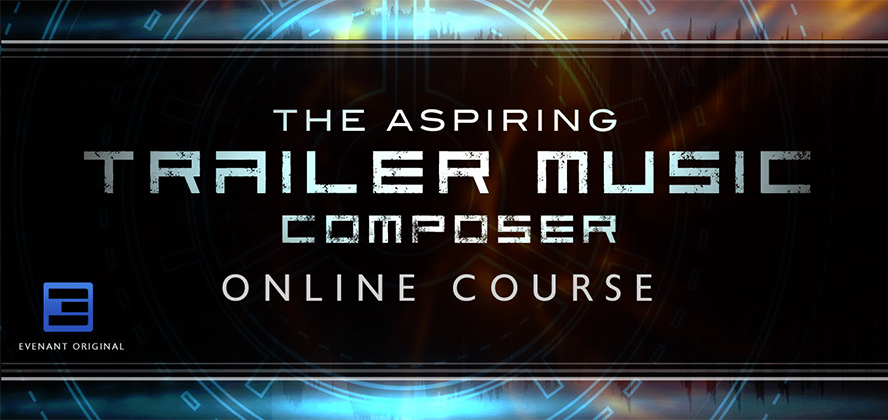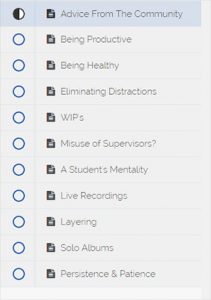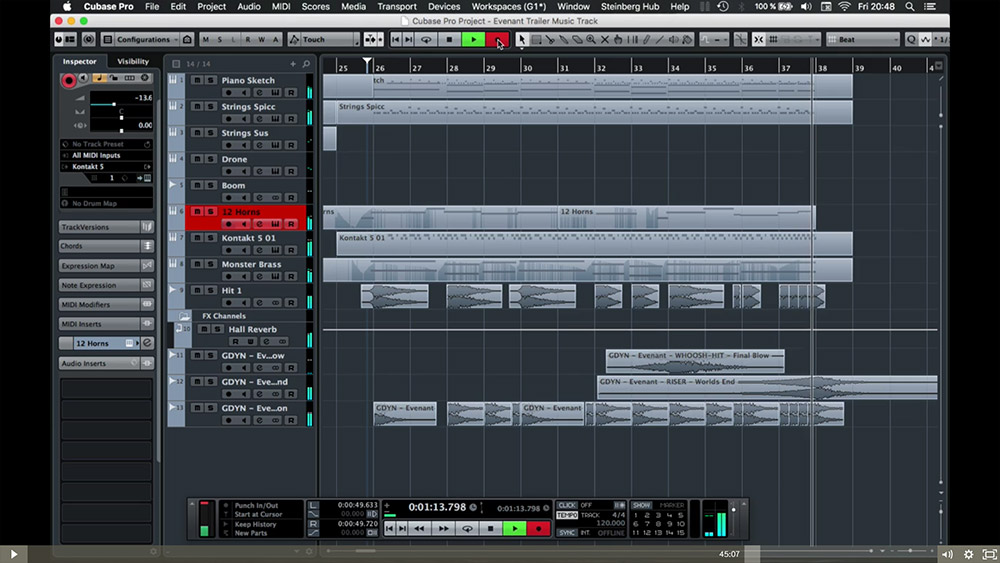Evenant The Aspiring Trailer Music Composer Course Review

I’m a huge fan of online learning. I can tell you first hand that it is possible to learn everything you need online to be successful. But that requires that you find the right teacher. So I thought it would be good to start doing coverage of some online music and composition training resources so you can spend your money and time wisely while you learn.
The first course I’ll be taking a look at is from Evenant, called The Aspiring Trailer Music Composer. The course is taught by Christian Baczyk, who lives and breathes the trailer music genre as a composer and publisher for the format.
Movie and television trailer music is a very distinct genre of soundtrack work, and there is more to know than most people realize. So I’ll break down exactly what you will learn, and whether The Aspiring Trailer Music Composer delivers.
The Aspiring Trailer Music Composer Course Format
This course is literally designed to be everything you need to learn about writing trailer music to accompany movie and television trailers. It seems to be assumed that you have an average level of orchestration and composition knowledge, as the course doesn’t go into great detail about the instruments themselves. You are expected to know a bit about how to write for various instruments, along with enough theory and other skills to come up with original ideas. But it doesn’t assume you are the world’s greatest. It will help to know general composition, though.
Beyond that, The Aspiring Trailer Music Composer takes you from learning how to write trailer music and what makes it unique, all the way through mixing your track and marketing your work. It’s a fairly hefty range of topics, honestly.
The course is made up of a combination of text and video instruction, along with numerous audio examples to demonstrate various sounds and techniques.
Most lessons are completely text based with trailer examples (from Youtube, as seen above) of the techniques being taught in that lesson. But there is also nearly 4 hours of actual course video, which we’ll cover shortly.
Most lessons are brief enough that you can read them in a matter of minutes, but as the course progresses, the lessons start to add some more depth. There is a lot of repetition within certain modules, but I’m ok with that because it really drives the core concepts into your mind.
 The core of this course revolves around the creation of trailer music tracks, as you would expect. Evenant discusses the structure and how each piece of a track contribute to a more effective trailer. There is a discussion on how each portion of your track affects the listener, as well as how each portion is important to the video editors. In fact, there is a lot of emphasis on creating a track that editors can work with. You’re given some insight into how the editors work and why each element is necessary. When these elements are first described, I was tempted to dismiss the idea of a cookie-cutter template for creating trailer music. But this extra insight into why these elements matter to the others in the pipeline was truly helpful.
The core of this course revolves around the creation of trailer music tracks, as you would expect. Evenant discusses the structure and how each piece of a track contribute to a more effective trailer. There is a discussion on how each portion of your track affects the listener, as well as how each portion is important to the video editors. In fact, there is a lot of emphasis on creating a track that editors can work with. You’re given some insight into how the editors work and why each element is necessary. When these elements are first described, I was tempted to dismiss the idea of a cookie-cutter template for creating trailer music. But this extra insight into why these elements matter to the others in the pipeline was truly helpful.
You learn a lot about edit and cut points, how to make your tracks more modular, how to create greater contrast and a lot more. You are given examples of common chord progressions used in trailer music and why the chords matter.
You are given a breakdown of how to create and use common trailer elements such as risers and braams, effective use of ostinato patterns, as well as why each part is important. In some cases, there is additional audiovisual content, such as the notation for some ostinato patterns along with MIDI file downloads. A nice touch, for sure.
So there is a lot of ground covered here, and there was a refreshing simplicity to it all. It’s actually an eye-opening look at just how similar most trailer tracks are, and the course lays out a definitive formula for creating a market-worthy trailer composition. Kind of like how the 1-4-5 chords are the staple of the majority of commercial music; trailer music has distinctive elements and patterns you can follow.
As previously mentioned, you aren’t given a primer in basic orchestration, but you are given some suggestions along the way of which types of instruments may be used during different sections of your track. You are given ideas on how to build your own percussion hits, whooshes, and other materials.
I can honestly say that I believe Evenant has covered every base when it comes to composing a trailer cue. Since going through this course, I’ve watched a lot of movie trailers to listen for structure and sound elements. And I can’t think of a single moment where I found something that wasn’t covered in this course.
 I mentioned already the hefty range of topics, and I want to emphasize that again. Most online music courses don’t offer this kind of scope. You are walked through every part of a typical commercial trailer track, from the structure to orchestral conventions. You are taught how to mix the track as well. But there is also a lot of ‘extra’ material here that goes beyond the production itself. I was expecting this extra material to be shallow and “filler”, but I was surprised how beneficial it was. Exhaustive? No. But impressive, nonetheless.
I mentioned already the hefty range of topics, and I want to emphasize that again. Most online music courses don’t offer this kind of scope. You are walked through every part of a typical commercial trailer track, from the structure to orchestral conventions. You are taught how to mix the track as well. But there is also a lot of ‘extra’ material here that goes beyond the production itself. I was expecting this extra material to be shallow and “filler”, but I was surprised how beneficial it was. Exhaustive? No. But impressive, nonetheless.
Evenant provides a full compliment of advice on productivity and staying creative, how to deal with a supervisor, how and when to submit your tracks, how to market your work, putting together a portfolio, finding a publisher, and more.
You’re also given suggestions for gear and sample libraries to get started with, among other things. And while these suggestions may not help somebody like myself who knows what is out there, it is nice to see that Evenant thought to include it. There is a feeling of completeness in this course.
Of course, not every lesson and topic is exhaustive. These extra topics are not designed to make you an expert in time management or an expert business person. But there is enough here that a complete beginner could learn some orchestration, then take this course and have enough information to get their feet wet in the trailer music industry.
One thing that I did find lacking was instruction on sound design. A large part of writing trailer music involves the creation of unique sounds. So I would have liked to see some more of this. There was some discussion on layering in the walkthrough videos and sprinkled throughout the lessons. But I would like to see more, which I’m told could be added at some point.
My only other gripe, and it is a minor one, is that The Aspiring Trailer Music Composer course lacks a bit of polish in terms of grammar and fluidity of the text. This isn’t important enough to warrant not buying the course, but it is worth mentioning as a side note. Sometimes the descriptive terms are very generic and not descriptive enough. Nothing that gets in the way of learning what you need. Not even close. But it does lack a bit of color in the writing itself, which would have helped when digesting some of the longer lessons.
The Aspiring Music Trailer Course Videos
Many people, such as myself, love learning through video. So my biggest interest going into the Aspiring Trailer Music Composer course was in how well the videos were done.
The video content contained in The Aspiring Trailer Music Composer is a great bonus. It is, however, supplementary in nature and not essential for learning the concepts in the course. They don’t teach any essential additional info, but instead, you get to watch a trailer music track be created from scratch.
The videos are not actually done by the course author himself either, but rather one of the founders of Evenant, Walid Feghali. This isn’t necessarily a problem, but it does merit a mention. Walid does mention getting advice from Christian (the course author) and then makes the adjustments as an addendum to the videos. But the walkthroughs are extremely consistent with the content of the course and are a perfect supplement to the materials, so the different author isn’t necessarily a distraction.
In addition to the creation of a track, you’re also given a couple of videos showing how to analyze an existing trailer cue to find structure, edit points and contrast. This is designed to supplement the textual materials on the same subject.
The walkthroughs are fairly helpful as it helps to break down the process visually. At this point in the course, you’ve already covered all the pieces of trailer music tracks, and the video walkthroughs let you see it all glued together. There isn’t a lot of exhaustive instruction in these videos, but the time is spent with Walid thinking out loud and revealing why each choice was made. From sketching each section on the piano to layering sounds and transitioning from one section to another, you get a look at how quickly you can put together a commercial trailer cue.
I won’t say that the video material alone is worth the cost of the course. But it most definitely doubles the value of what is already there. The video alone isn’t, and shouldn’t be, what you purchase this course for. The real info, and thus the real value, is in the lessons themselves. But without the video content, the course wouldn’t feel as complete. The videos help to fill in the gaps of logic and the human thought process as you watch and listen to the process you’ve already learned about.
Getting additional help from Evenant
Every lesson includes the ability to comment with your questions and thoughts regarding that lesson. There is nothing particularly special about the commenting system itself, but what it does provide is some direct access to both Evenant as a whole as well as Christian himself.
While I did not personally ask any questions, I did browse through the comments on most lessons, and it was refreshing to see that almost every comment needing a reply got one from the authors. And I actually found many of the replies added some great additional insight into the thought process behind the subject of the lessons.
How long will these comments continue to be answered? Probably not forever. But at this time, the comments system is very active and obviously monitored closely by Evenant and Christian. And this is something most courses don’t offer you, quick and direct access to instructors.
Taking it all in, writing Trailer Music
I’ll be honest. I didn’t go into this as somebody who has done any trailer music or even thought about it that much. I appreciate trailers that grab me, and as a composer, the music has fascinated me. But I’ve never had the thought that I wanted to write trailer music.
This course has really shifted my thinking. I actually want to put together some cues and pitch them. Regardless of the chances of landing a licensing deal, the course is certainly inspiring. Part of this is how much it simplifies the process. I kept thinking to myself, “ya know, this really isn’t that hard to do” all the way through. Evenant does a fantastic job of breaking things down to a modular level.
The wealth of information in The Aspiring Trailer Music Composer is unique. I’m not aware of any other resource that covers the same subject matter, and this is refreshing. If you have the desire to do movie and television work but aren’t ready for full-on soundtrack creation, I believe this could be the perfect avenue to pursue. If you’ve ever wanted to write trailer music, there is no better way to learn than this course.



